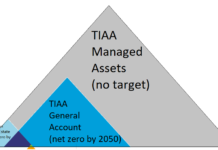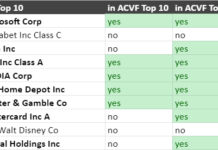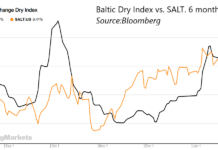My Quick Clean Energy Tracking Portfolio has produced unexpected out-performance. Is it because of high beta (β) in a rising market?
I recently asked why two portfolios which I had designed to track green energy mutual funds ended up out-performing them by a wide margin.
This is the first of a short series of articles looking into possible causes. Could the portfolios be outperforming because the stocks they contain rise more when the market rises (and fall more when the market falls) than do the mutual funds they were designed to track? In other words, are they out-performing because of high beta (β) in a rising market?
A Beta Definition
From Wikipedia,
In finance, the beta (β) of a stock or portfolio is a number describing the relation of its returns with that of the financial market as a whole.[1]
An asset with a beta of 0 means that its price is not at all correlated with the market; that asset is independent. A positive beta means that the asset generally follows the market. A negative beta shows that the asset inversely follows the market; the asset generally decreases in value if the market goes up and vice versa.[2]
That’s a basic definition. It’s worthwhile to note that β changes for any stock or portfolio over time (usually slowly, but sometimes quickly in times of market turmoil.) Measured β will also vary depending on the time increment used (are we interested in daily, weekly, monthly, or even hourly changes of a stock with respect to the market,) and it will also vary depending on which market index is used as a proxy for the market as a whole. In my recent article on hedging using beta, I showed a graph with three measures of beta for my portfolio against various market indexes.
Mathematically, if S is a stock (or portfolio) and M is the market index, then
β = correlation(S,M) x std.dev(S) / std.dev(M)
or
β = covariance(S,M) / variance(M).
Either formula can be calculated with standard spreadsheet functions. I gave an example using the first formula in my hedging article, and a spreadsheet using the latter formula is available here. In both cases, the change in S will be β times the change in M, plus an error term which is uncorrelated to the change in M.
Why High Beta Would Explain Out-Performance
I created my tracking portfolios at the end of February, which was, co-incidentally, right before the stock market began its recent rise. From this graph,

you can see that both tracking portfolios have out-performed nearly every possible benchmark. In the first article in this series, I attributed the difference between the two tracking portfolios to "winner-loser" effects (hence the names of the portfolios.) In theory, without these effects, those portfolios should have produced returns approximately equal to the average of the two.
Since the S&P 500 (my proxy for the market) gained 43% over the period in question, while the mutual funds gained 56% on average, and the tracking portfolios gained 80% on average, if β were the sole reason for the out-performance, we would expect that the average mutual fund β would be about 1.3 (=56%/43%) while the average tracking portfolio β would be about 1.9 (=80%/43%.) There will be significant errors in these calculations (recall the random error term and other caveats from the definition of β), but we should at least expect that the β of the tracking portfolios is higher than the β of the mutual funds.
In fact, I do not expect that the out-performance of the mutual funds over the S&P500 will all be due to β. In April, I argued that clean energy in general was outperforming the market due to the greater political support shown by the Obama administration compared to previous administrations, something I dubbed the "Obama Effect." If this is true, then the β for the mutual fund portfolio will be less than 1.3, but β could still explain the out-performance of the tracking portfolios if their β is approximately 0.6 greater than the β for the mutual fund portfolio.
Calculating β
β for a portfolio is the weighted average of the β’s of the portfolio’s components. Furthermore, Yahoo! Finance provides some pre-calculated β’s (from Capital IQ, a division of Standard & Poors), but not for all securities in my portfolios. Furthermore, I was unable to determine the market index used to calculate the Yahoo! β’s.
I used the last 200 trading days of stock market data for the securities in question, and the formula above to calculate β with respect to my market proxy, the S&P 500, using an Excel spreadsheet. Here are the results:
| Stock/Portfolio | Beta (β) |
| CGAEX (Calvert) | 0.916 |
| ALTEX (First Hand) | 0.912 |
| GAAEX (Guinness Atkinson) | 1.117 |
| NALFX (New Alternatives) | 0.812 |
| WGGFX (Winslow Green Growth) | 1.123 |
| Mutual fund Portfolio | 0.974 |
| LSB Industries (LXU) | 1.078 |
| Echelon Corporation (ELON) | 1.573 |
| First Solar Inc (FSLR) | 1.067 |
| South Jersey Industries (SJI) | 0.360 |
| American Superconductor (AMSC) | 1.675 |
| "Winners" Portfolio | 1.151 |
| Citrix Systems (CTXS) | 0.979 |
| Echelon Corporation (ELON) | 1.573 |
| SunTech Power (STP) | 2.186 |
| Cemig (CIG) | 0.996 |
| Vestas Wind Systems (VWSYF.PK) | 1.318 |
| "Losers" Portfolio | 1.410 |
| Average of "Winner" and "Loser" portfolios | 1.281 |
A Partial Explanation
The average β of the tracking portfolios is 0.3 more than the mutual fund portfolio β, but we needed a difference of about twice that to explain all the out-performance. We also see the Obama effect here, which accounts for the 13% out-performance of the mutual funds over the S&P 500.
My calculated β’s, plus the Obama effect on green stocks and funds, can explain an average performance of the tracking portfolios of about 70% over the time period in question, leaving about 10% of the out-performance unexplained.
As I hypothesized in the previous article, this out-performance could also arise from the way I chose the stocks, which created a bias towards some Cleantech sectors (mostly efficiency stocks and smart grid stocks) when compared to the mutual funds. It could also be the mutual fund managers’ skill. In either case, however, an out-performance of 10% during seven months which have been as volatile as these last seven would not be enough for me to reach any firm conclusions. 10% is small enough to be a bias in my β calculations (recall that β depends on the choice of index as well as the frequency of the data used, and it also changes over time.) 10% could also be just luck.
Since I won’t be able to show that any out-performance which remains is not just luck, I see no need to continue this investigation.
An Inadvertent Discovery
It’s interesting to note that the β for the "Losers" is higher than that for the "Winners." In other words, I was wrong to attribute the out-performance of the "Losers" portfolio to winner-loser effects. "Loser" out-performance is also explained by β. Why do the "Losers" have higher β than the "Winners"? Because the "Losers" were the worst-performing of a group of stocks from 2/27/2006 to 2/27/2009, over which period the S&P 500 fell 43%. Since high-β stocks are likely to fall more than low-β stocks when the market as a whole is falling, my "Losers" portfolio was biased towards high-β stocks.
None of this explains why the "Winners" portfolio also has higher β than the mutual funds. While the "Losers" were selected with a high-β bias, the "Winners" were selected with a bias towards low-β stocks. We would therefore expect that the "Winners" portfolio would have a β lower than the mutual funds from which they were drawn.
Here are some reasons that the mutual fund β’s are lower than the β’s of their top holdings.
- Mutual funds need to maintain a cash reserve in order to meet redemptions. Cash has a β of 0, and so an allocation to cash will lower the funds’ β overall. For instance, the Calvert fund holds about 4% cash. Without the cash, the Calvert fund’s β would be 0.954 rather than 0.916. However, the funds would have to be holding about 20% cash for this to be a full explanation.
- The greater emphasis of my portfolios on energy efficiency and smart grid technologies does not account for the bias. The average β for these companies in my portfolios was about the same as the portfolios as a whole.
- The funds own a good number of diversified companies with exposure to green energy, but they do not own enough of many of these to put them in the top holdings of the funds. One example would be Applied Materials (AMAT), a semiconductor firm with growing interests in solar. Such firms will generally have lower β than pure-play firms, which is why I suggested readers invest in AMAT and nine other large companies with green energy exposure in the spring of 2008: I was concerned about a market decline (not that I had any clue how bad it would be) and low-β stocks are likely to fall less during declines.
Implication: More Bang For Your Buck
The discovery that the top holdings have higher β than the funds has some implications for tracking portfolio creation. In order to better match the gains and losses of the mutual funds, we will need to invest less money. By holding some cash, β can be lowered. Alternatively, by investing the same amount, an investor can get more exposure to the positive trends affecting green energy, such as peak oil and the advent of carbon regulation.
That’s why we’re here, isn’t it?
DISCLOSURE: Tom Konrad and/or his clients own AMAT, LXU, ELON, and AMSC. The Guinness Atkinson Fund is an advertiser on his website, AltEnergyStocks.com
DISCLAIMER: The information and trades provided here and in the comments are for informational purposes only and are not a solicitation to buy or sell any of these securities. Investing involves substantial risk and you should evaluate your own risk levels before you make any investment. Past results are not an indication of future performance. Please take the time to read the full disclaimer here.








